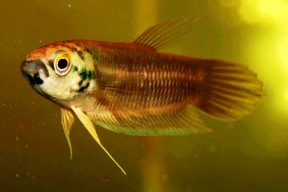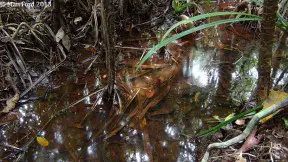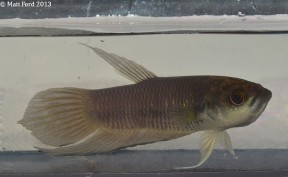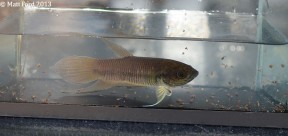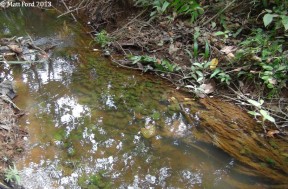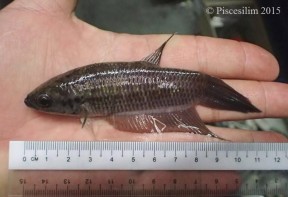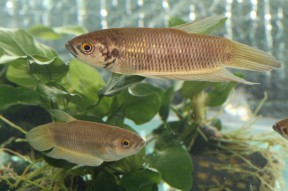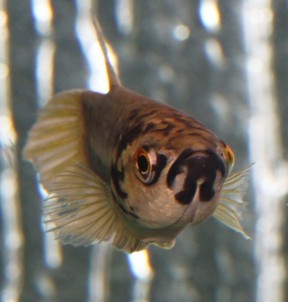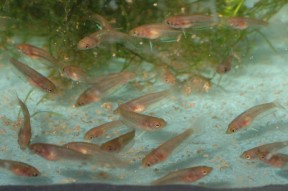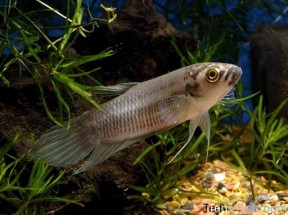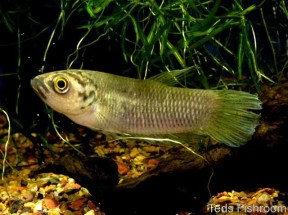Betta pi
Etymology
Betta: from ikan betah, the vernacular Malay for species of this genus.
pi: named in reference to the Greek letter π (pi), in allusion to the shape of the dark marking on its throat.
Classification
Order: Perciformes Family: Osphronemidae
Distribution
This species is known from the Pru Toe-Daeng peat swamps in southern Thailand near the border town of Sungai Golok, and its range also extends into northern Peninsular Malaysia where it has been collected in the states of Kelantan and Terengganu.
Type locality is ‘Thailand: Narathiwat Province, Mae Nam Tod Deng, about 6 kilometers north of Sungai Kolok, open area in swamps ca. 100-200 m south before bridge’.
Habitat
eat swamp forests and associated black water streams, although it does also occur in freshwater swamp forest.
The dense canopy of branches above means very little light penetrates the surface of such environments, and riparian vegetation also tends to grow thickly.
The water is typically stained darkly with humic acids and other chemicals released by decaying organic material. The dissolved mineral content is generally negligible and pH can be as low as 3.0 or 4.0. The substrate is usually covered by fallen leaves, branches and submerged tree roots and at certain times of year the fish may be forced to survive within the moist leaf litter for several weeks as permanent water is not always available.
Many of its habitats have been degraded by the activity of man with areas of primary forest removed and replaced with commercial rubber or oil palm plantations.
Maximum Standard Length
80 – 90 mm.
Aquarium SizeTop ↑
An aquarium with base measurements of 90 ∗ 30 cm or equivalent is large enough for a pair or small group.
Maintenance
Can be maintained in a fully-decorated aquarium although many breeders prefer not to use a substrate for ease of maintenance. Driftwood roots and branches can be used and placed such a way that a few shady spots are formed, while clay plant pots or lengths of piping can also be included to provide further shelter.
The addition of dried leaf litter offers additional cover and brings with it the growth of microbe colonies as decomposition occurs. These can provide a valuable secondary food source for fry, while tannins and other chemicals released by the decaying leaves are considered beneficial for fishes from blackwater environments. There is no need to use natural peat, however, the collection of which is both unsustainable and environmentally-destructive.
Like others in the genus this species seems to do best under fairly dim lighting. Aquatic plant species that can survive under such conditions include Microsorum, Taxiphyllum or Cryptocoryne spp., while floating vegetation is also appreciated by the fish.
This species requires acidic conditions with negligible carbonate hardness and very low general hardness, meaning a reverse osmosis unit or other method of obtaining soft water may need to be employed. This can be further acidified using phosphoric acid or similar if necessary.
As it naturally inhabits sluggish waters filtration should not be too strong, with an air-powered sponge filter set to turn over gently adequate. Keep the tank well-covered and do not fill it to the top as like all Betta spp. it requires occasional access to the layer of humid air that will form above the water surface, and is an excellent jumper.
Water Conditions
Temperature: 22 – 28 °C
pH: 4.0 – 6.5
Hardness: 18 – 90 ppm
Diet
Likely to prey on aquatic and terrestrial invertebrates in nature.
Captive fish will normally accept dried products once they are recognised as edible, but should be offered plenty of small live or frozen foods such as Daphnia, Artemia or chironomid larvae (bloodworm) regularly to ensure development of optimal colour and condition.
Take care not to overfeed as Betta spp. seem particularly prone to obesity.
Behaviour and CompatibilityTop ↑
Not recommended for the standard community aquarium. Its care requirements and disposition mean it is best kept alone or with very peaceful species. Some small cyprinids and loaches that inhabit similar environments in nature are suitable, but proper research prior to purchase is essential and in most cases it is best maintained alone.
It is not among the more aggressive members of the genus and can be maintained in a pair or group.
Sexual Dimorphism
Adult males grow larger, develop more-extended fins, and have a broader head shape than females.
Reproduction
Paternal mouthbrooder. Ideally organise a separate aquarium for breeding purposes, unless the fish are already being maintained alone.
The aquarium should have the tightest-fitting cover possible (some breeders use clingfilm/plastic wrap) because the fry need access to a layer of warm, humid air without which development of the labyrinth organ can be impaired.
Following a protracted courtship, eggs and milt are released during an ’embrace’ typical of osphronemids, with the male wrapped around the female. Several ‘dummy’ embraces may be required before spawning commences.
Fertilised eggs are caught on the anal fin of the male then picked up in the mouth of the female before being spat out into the water for the male to catch. Once the male has all the eggs in his mouth the process is repeated until the female is spent of eggs, a process which can take some time.
A brooding male may swallow or release the eggs prematurely if stressed or inexperienced, so it is preferable to leave the female and any other fishes in situ. The incubation period is 10-28 days, after which the male will begin to release free-swimming fry. Unusually, the male may accept food during this period. The adults tend not to eat fry, and some breeders have reported them to develop at a faster rate when left with the parents.
The fry are large enough to accept motile foods such as microworm and Artemia nauplii immediately, though it should be noted that there exist reports of young Betta developing health issues if fed excessive amounts of the latter. Water changes should be small and regular rather than large and intermittent.
NotesTop ↑
B. pi is included in the Betta waseri group of closely-related species within the genus, an assemblage within which members share the following combination of characters: base body colouration clay yellow; opercle scales iridescent gold in mature males of all species except B. tomi; throat with black markings which join with black lower jaw in some species; no chin bar.
The easiest way to distinguish these is by examining the throat markings, which vary according to species, and in the case of B. pi form a shape that resembles the Greek letter π (pi).
It can also be separated from other group members by the following suite of characters: π-shaped dark marking on the throat; no transverse bars on dorsal and caudal fins; anal fin with a thick blue distal band in both males and females; lower portion of opercle black; 5.5-6 subdorsal scales; 11-12 postdorsal scales; 32-33 lateral scales.
The genus Betta is the most speciose within the family Osphronemidae. Members have successfully adapted to inhabit a variety of ecological niches from stagnant ditches to flowing hill streams including some extreme environments such as highly acidic peat swamp forests.
The referral of members to a number of groups containing closely-related species is largely based on morphological and behavioural characters. A full list of the species groups as currently recognised can be found here.
Like others in the suborder Anabantoidei this species possesses an accessory breathing organ known as the labyrinth, which permits the fish to breathe atmospheric air to a certain extent. Comprising paired suprabranchial organs formed via expansion of the epibranchial (upper) section of the first gill arch and housed in a chamber above the gills, it contains many highly-vascularised, folded flaps of skin which function as a large respiratory surface. Its structure varies in complexity between species, tending to be more developed in those inhabiting harsher environments.
References
- Tan, H. H., 1998 - Ichthyological Exploration of Freshwaters 8(3): 281-287
Description of two new species of the Betta waseri group (Teleostei: Osphronemidae). - Kottelat, M., 2013 - Raffles Bulletin of Zoology Supplement 27: 1-663
The fishes of the inland waters of southeast Asia: a catalogue and core bibiography of the fishes known to occur in freshwaters, mangroves and estuaries. - Schindler, I. and J. Schmidt, 2006 - Zeitschrift für Fischkunde 8(1/2): 47-69
Review of the mouthbrooding Betta (Teleostei, Osphronemidae) from Thailand, with descriptions of two new species. - Tan, H. H. and P. K. L. Ng, 2005 - Raffles Bulletin of Zoology Supplement (13): 43-99
The fighting fishes (Teleostei: Osphronemidae: Genus Betta) of Singapore, Malaysia and Brunei.

